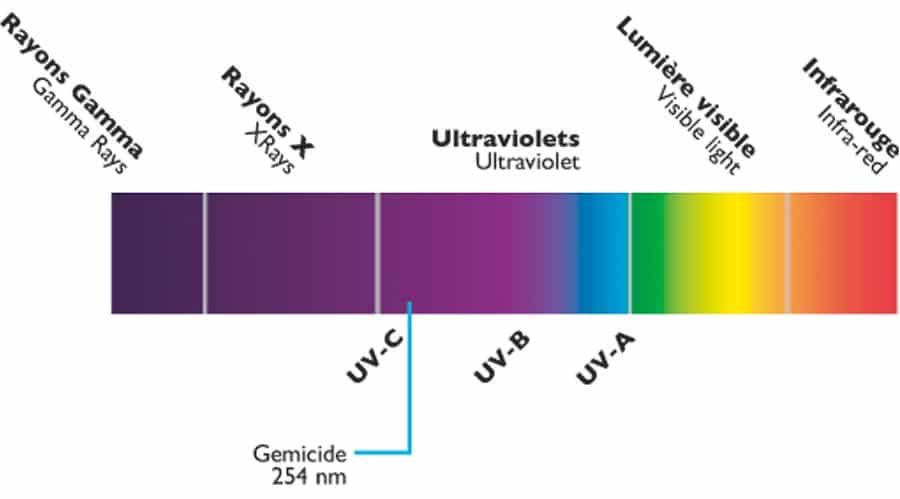
Want to learn more about algaecide? Read on to find out when to add algaecide to your pool maintenance routine and other helpful tips.
One of the latest and greatest innovations in pool technology is the use of UV rays for pool sanitation and treatment. This UV system is a supplemental pool tool that can greatly increase the cleanliness of your pool as long as it is used in an efficient way. We at Pool Calculator are going to dive into the technology behind this pool innovation, the costs associated with getting on the UV bandwagon, and determine whether or not a UV pool sanitizer is a good investment for you.
For more on Swimming Pool Technology:
To learn cool info on solar pool covers
The revolution of robotic pool cleaners
Click here for a deep dive on LED pool lights
UV sanitation sounds complicated, but is actually quite simple. The main job of UV sanitizers is to eliminate chlorine-resistant microorganisms in your water. These are pesky organisms that cannot be cleaned by usual means. These organisms are often the cause of many pool closures and can cause big problems. The UV sanitizer does this by reproducing UV radiation inside light chambers. These chambers then release UV-C light that is used to kill bacteria and clean your pool water.
This UV-C light is also beneficial for other reasons. The light can improve water and air quality in aquatic facilities. All of these facts combine to show that treating your pool with UV light is beneficial and poses no health concerns or risks. This is a significant advantage over many of the chemical-based treatment options available. These options, while cheaper, are also less clean.

This light treatment is also special for a couple other reasons. The first of which is that it permanently disrupts and kills the microorganisms. Once these organisms are killed or stalled, they are also unable of replicating. This stunts their growth and capability to breed. The UV rays also do not alter the composition of your water. This means you won’t have to further treat your pool in order to make way for the UV treatment.
However, UV rays are somewhat limited in scope. Treatment is only possible to water that has direct exposure to the light. This means you will likely need multiple lights to reach the majority of your pool. This fact is paired with the fact that UV treatment is only seen as a secondary sanitation system. UV systems will need to be paired with a halogen in order to truly clean your pool to the full extent.
The primary downside of using UV sanitizers is the price to install and implement the sanitizers into your pool. Large aquatic centers that have installed full UV sanitation systems have cost anywhere from $50,000 to $100,000 in the past. While this cost is cut drastically for smaller residential pools, you can still expect to spend thousands of dollars on the technology.
The barrier to entry is also quite high at this point. However, those who have invested in UV tech seem to be happy with the results. The large cost associated with these systems can largely be attributed to the clean and revolutionary nature of the tech. The tech also has an efficiency at which it runs and cleans. We also believe as the technology evolves and becomes more “normal” in typical swimming pools we will see those costs lower for the public.
I believe most consumers should take the wait-and-see option when it comes to UV sanitation. The technology IS cutting edge. The sanitation IS efficient. It DOES seem like the future of pool filtration. However, the cost and barrier to entry for most consumers that aren’t extremely wealthy seems too high at the moment.
The technology is still very expensive. UV sanitizers also have to be complemented with another water treatment system in order to offer a full clean. Large centers with the need for efficient and quick cleaning will make use of these systems for the time being, and probably love the results. However, I see the technology as being too expensive for mass use. There is a huge potential for a large push in the future for these systems to become a mainstay in smaller pools and residential areas. But for now your wallet likely won’t be able to justify the purchase.

Want to learn more about algaecide? Read on to find out when to add algaecide to your pool maintenance routine and other helpful tips.

In this quick guide, we’ll answer the question “can you over shock a pool” and unveil the factors to consider when shocking a pool.

Maintaining both pH and total alkalinity in your swimming pool is important for keeping your pool properly sanitized and non-corrosive. Total alkalinity is to pH what cyanuric acid is to free chlorine. Total alkalinity stabilizes pH levels. The ideal pool pH level is 7.4 to 7.6. The ideal total alkalinity level is 80 to 120 ppm.

The Association of Pool and Spa Professionals recommends free chlorine levels for both swimming pools and hot tubs be kept between 2.0 and 4.0 ppm. However, the Center for Disease Control recommends free chlorine stay above 1 ppm in pools and 3 ppm in hot tubs.